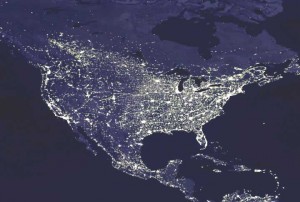 By Matthew Cimitile, cimitile@msu.edu
By Matthew Cimitile, cimitile@msu.edu
Great Lakes Echo
As the world gears up to turn off its lights for Earth Hour Saturday, researchers and stargazers suggest a need to reduce excessive light pollution permanently.
In the industrialized world, dark skies pierced with radiant starlight are increasingly rare. Starlight that guided earlier humans down from the trees and through the wilderness and uncharted waters to every corner of the planet has rapidly vanished.
That leaves a dimmer view that some researchers say may cause health problems from breast cancer to insomnia.
But stargazers, astronomers, conservation experts and health advocates are attempting to regain the night sky to ignite wonder, save energy and protect health. The Great Lakes region features several dark sky preserves and a newly designated park.
Since the invention of the light bulb in 1879 by Thomas Edison, streetlights, neon signs and traffic lights have become a fixture for every major city, town and suburban residence. Such lighting illuminates sidewalks and houses when the sun sets, but also blasts photons into the sky, washing out most planets and stars that populate Earth’s zip code.
“In many cases, we are over lit as a society,” said Kim Patten of the International Dark Sky Association in Tucson, Arizona.
Begun in 1988, the International Dark-Sky Association is a non-profit group that promotes the benefits of intelligent, sensible lighting that reduces waste, saves energy and recaptures the awe of night.

Dark skies are still available in parts of the world but are increasingly rare in industrialized nations. Courtesy of NASA
Using dark sky friendly products and retrofitting common streetlights limits light pollution and saves money, Patten said.
“The city of Calgary went through a lighting retrofit program and is now projecting a $1.7 million a year savings in energy alone,” she said.
The group says that other benefits include reducing the impact such light has on bird migrations and amphibian reproduction.
The association also designates dark sky parks at areas that mitigate light pollution and value natural darkness as an important natural resource.
The newest honoree is Ohio’s Geauga Park (see slideshow). Spurred by a coalition of conservationists, amateur astronomers and educators, the sprawling 1,100-acre public park in northeast Ohio in several years will introduce new generations to what the Milky Way should looked like.
“ Its remoteness coupled with the community’s efforts in reducing light pollution make this site have particularly good night skies,” said Tom Curtin, executive director of the Geauga Country Park District.
In recent years the district retrofitted streetlights with shields and installed fixtures to focus light downward, said Curtin. Now it is helping to establish local light ordinances that will secure the night sky for years to come.

In and around Chicago are 10 million people and their footprint can easily be seen at night.
Though such spaces provide spectacular views, it may be the health benefits that provide incentives to create more dark sky areas.
In the mid-1980s, professor Richard Stevens of the University of Connecticut and other researchers uncovered how extensive artificial light exposure may affect circadian rhythm and increase the risk of certain cancers.
“We evolved with bright spectrum days and really dark nights, with most light at night coming from the moon,” said Stevens. “But the moon is a lot dimmer than the electric light around us today, so the last 120 years has seen a drastic change in the night environment.”
Constant exposure to light has been shown to suppress melatonin, a hormone that helps regulate other hormones while maintaining the body’s circadian rhythm, the 24-hour natural cycle displayed in many organisms. Darkness stimulates the production of this key hormone.
Past studies have shown a strong correlation between women exposed to large amounts of artificial light at night and breast cancer, said Stevens. And a 2008 study of men in 164 countries found that those who live in nations with the highest levels of nighttime light are more likely to develop prostate cancer. Researchers found the incidence of prostate cancer increased by 30 percent in countries with medium exposure and 80 percent in countries with the highest level of artificial light
Further research is now looking into possible links between exposure to light and the frequency of obesity and diabetes, said Stevens.
Some good background on Earth Hour can be found here: http://globalwarming.change.org/blog/view/earth_hour_tonight_at_830_2030_local_lights_out_to_stop_global_warming_earthhour
Great story Matt! I wonder if anybody has done any studies that look at the effects of both noise AND light pollution on humans.
Pingback: Cover the Planet » Blog Archive » Night flight: Using NASA’s satellite imagery in pursuit of environmental journalism